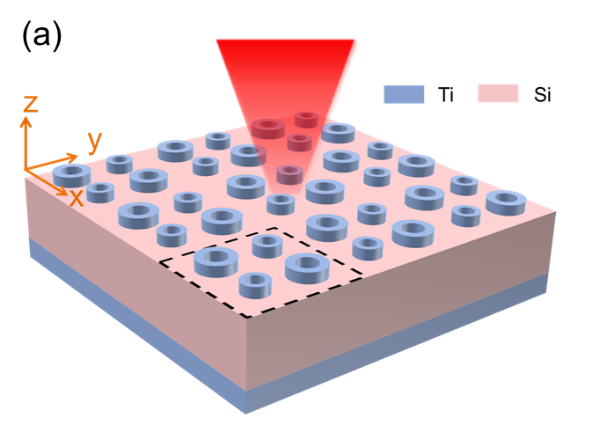Author: QIN Zheng |
Metamaterial absorbers (MA) based on subwavelength periodic patterns can achieve perfect absorption at any target wavelength by rationally designing their geometric parameters. Due to their ultra-thin thickness and near-field enhancement, MAs are widely used in infrared imaging, thermal emitters, photodetection, solar energy harvesting, gas detection, etc. However, since the resonant nature of plasmon excitation, general MAs can only achieve perfect absorption in a narrow wavelength range.
Researchers from the State Key Laboratory of Applied Optics, Changchun Institute of Optics, Fine Mechanics and Physics (CIOMP) of the Chinese Academy of Sciences (CAS) reported progress on broadband metamaterial absorber. This work proposed a broadband, polarization-insensitive, angle-insensitive metamaterial absorber design covering the long-wave infrared (LWIR) band. This study published in Optics Express.
The incident light coupled with the upper metal pattern of the MA excites localized surface plasmon resonance (LSPR). It induces antiparallel currents in the upper and lower metal layers so that the energy is confined in the MA. General broadband MAs are based on the combination of multi LSPR modes and the intrinsic absorption of lossy dielectric layers. In addition, rationally designed 2D metal grating structures can also excite propagating surface plasmon resonances (PSPR) at the metal-dielectric interface.
Based on the above theory, the researchers introduced PSPR into the patterned metal-dielectric-metal sandwich structure of MA. The top pattern of the MA consists of two alternating ring sizes, with the four adjacent rings forming a superunit, making the MA two distinct periods. Therefore, the MA excited multiple modes of surface plasmon resonance, and the lossy metal enabled the four absorption peaks with wide full width at half maximum, and finally a perfect broadband absorption covering the LWIR band was obtained.
Compared with previous broadband absorbers, the excitation of hybrid modes can achieve broader wavelength band absorption with a more straightforward structure. In addition, the energy of the incident light is all concentrated in the metal layer of the MA, which allows us to flexibly select the material of the dielectric layer according to the actual application scenario.
This MA design may have promising applications for infrared imaging, thermal detection, and radiation cooling.

Figure1. Schematic diagram of the metamaterial absorber
MENG Dejia
State Key Laboratory of Applied Optics Changchun Institute of Optics, Fine Mechanics and Physics
E-mail: djmeng@sklao.ac.cn
